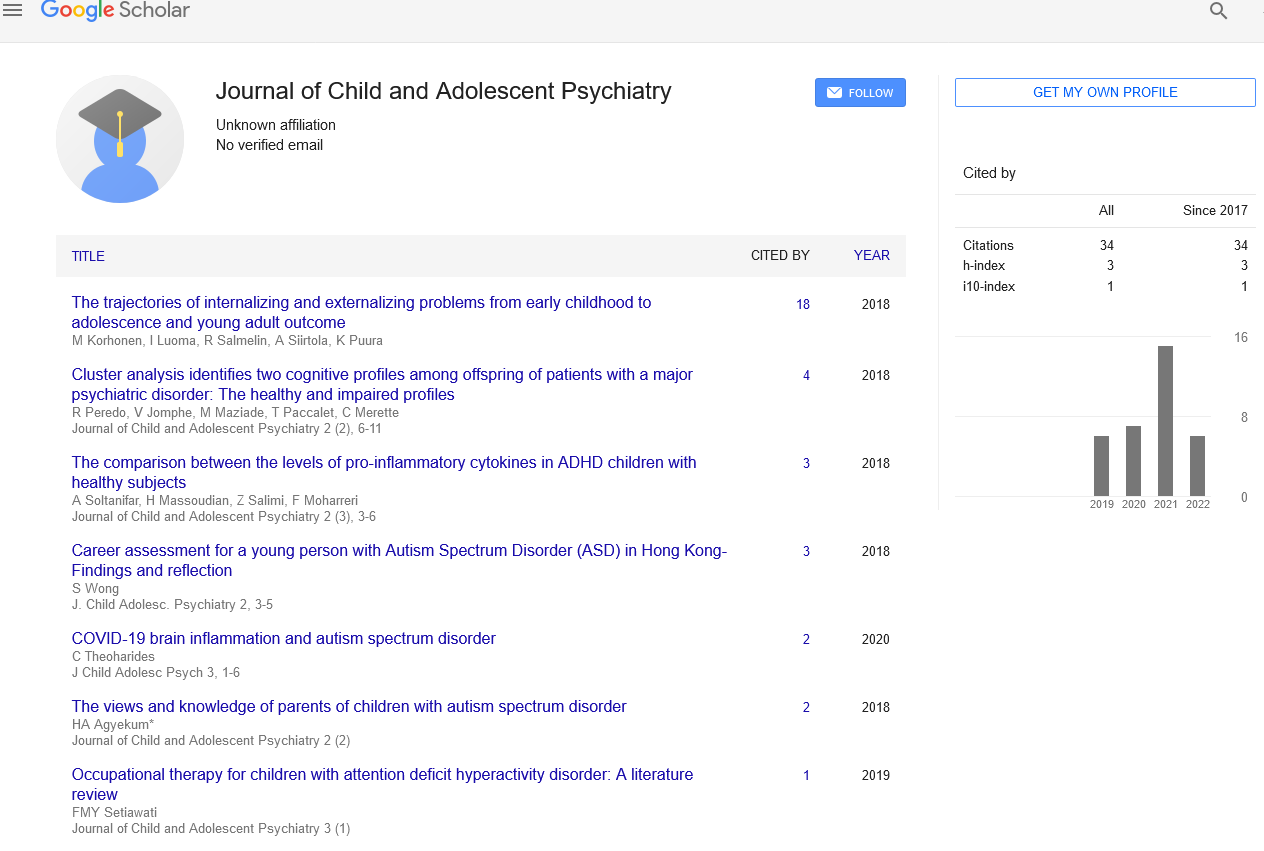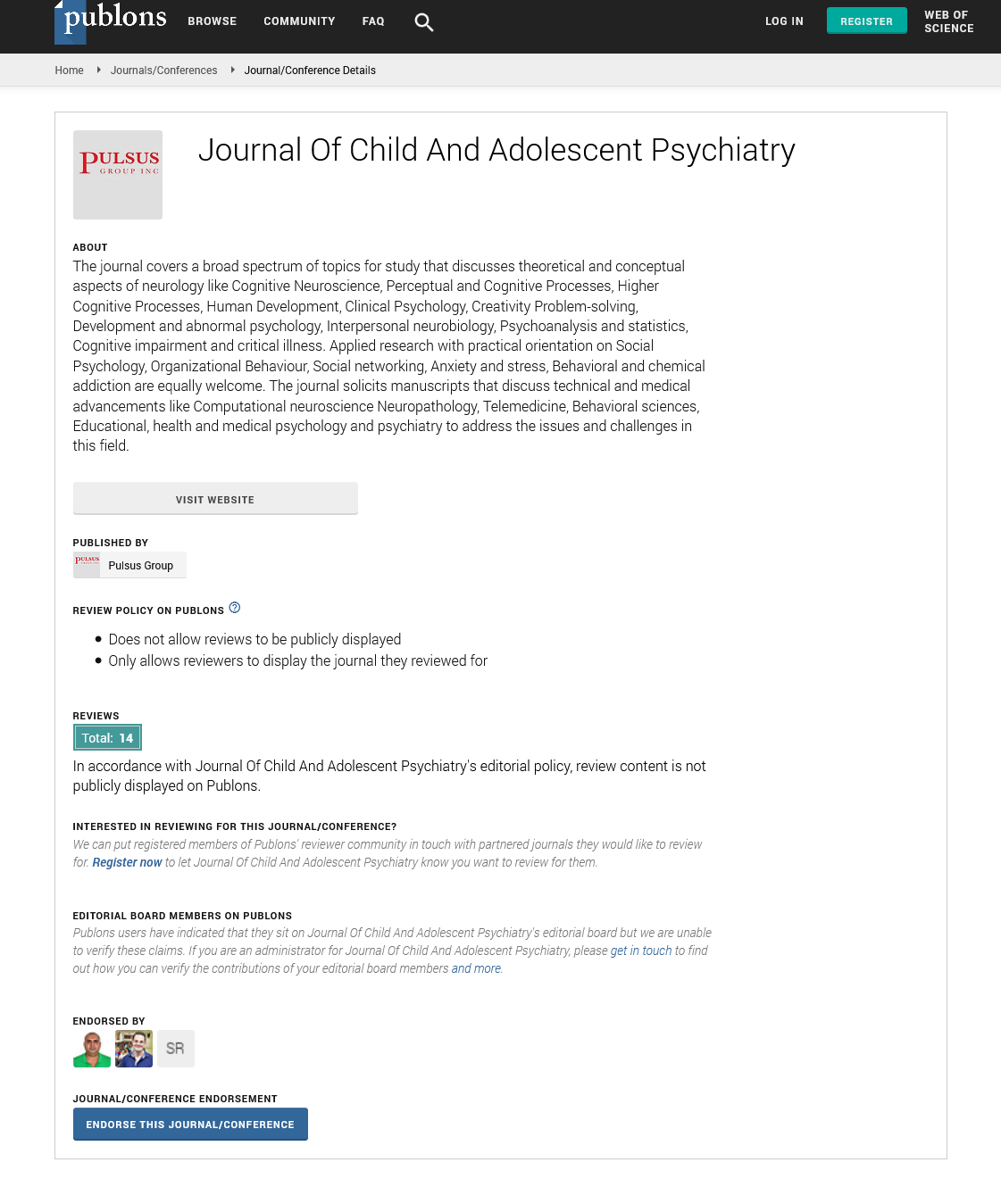Autism Aetiology: The journey of discovery from the “refrigerator mother’’ to the neurodevelopmental hypothesis
Received: 17-May-2018 Accepted Date: May 23, 2018; Published: 26-May-2018
Citation: Joseph J. Autism Aetiology: The journey of discovery from the “refrigerator mother’’ to the neurodevelopmental hypothesis. J Child Adolesc Psych. 2018;2(2):1-2.
This open-access article is distributed under the terms of the Creative Commons Attribution Non-Commercial License (CC BY-NC) (http://creativecommons.org/licenses/by-nc/4.0/), which permits reuse, distribution and reproduction of the article, provided that the original work is properly cited and the reuse is restricted to noncommercial purposes. For commercial reuse, contact reprints@pulsus.com
Leo Kanner a child psychiatrist in the US reported a clinical description in 1943 based on his observation of 11 children who were extremely preferred for loneliness and highly focused on objects with repetitive patterns of behaviour. An Austrian paediatrician Hans Asperger (1944) reported similar symptoms mostly with people of high intelligence [1]. Kanner proposed these symptoms as ‘childhood or early-onset schizophrenia’ (1944), later he coined it as a specific condition called ‘infantile autism’. Many theories and hypothesis were emerged to explain this enigmatic condition [2].
Aetiology to autism was first portrayed by Leo Kanner who attributed autism to a lack of maternal warmth and attachment. Bruno Bettleheim’s book - The Empty Fortress (1967) widely popularized the theory of “refrigerator mother” in which maternal coldness or emotionless parenting style were explicated for developing autism. Bettleheim’s notion of blaming the parents for their children’s autism was largely criticized and currently it is as an obsolete concept [3].
Several cognitive models attempted to untangle the conundrum in autism aetiology by following a symptomatology or phenotype approach. In this, the theory of mind hypothesis was the pioneer one which suggests that children with autism have a deficit in understanding the feelings of themselves and others which were manifested as ‘self-absorption’ in social situations [4]. The theory of executive dysfunctioning hypothesis proposes that children with autism have some restricted patterns of behaviour such as obsessive sameness,rocking,repetitive hand flapping,difficulty in sustaining attention and these problems of executive functions are akin to the deficit in motor tasks associated with certain brain injuries such as frontal lobe damage. The weak central theory hypothesis further expounded the ritualized patterns of behaviour in autism by suggesting that individual with autism have a weak drive for global coherence in which they process information in a detailed manner ranging from pedantry to obsession [5]. However, all of these approaches failed to explain both the pathogenesis and phenotypes of ASD.
The biological research identified an excessive brain growth during early developmental life in the child with autism following a normal developmental period. This was explained as “anabolic hypothesis” in which autism was attributed to abnormal enlargement of brain volume that results from neuronal overgrowth. Although macrocephaly is considered as one of the most replicated biological findings, the emerging evidence supports the role of both hyper and hypoactivity of certian functional areas of the brain in autism [6]. The empirical data also suggests that autism may be associated with imbalanced levels of certain neurotransmitters such as GABA, serotonin, glutamate and dopamine [7]. Autism predominantly affects boys than girls and the twin and family studies advocates the possible link of heritability for autism. However, more research is required to establish autism as a disorder of abnormalities in the genetic pathways such as X linked autosomal recessive or dominant [8].
DSM-5 defines Autism spectrum disorders (ASD) as a neurodevelopmental condition characterized by persistent impairment in reciprocal social communication and social interaction and restricted, repetitive patterns of behaviour, interests or activities [9]. Recent epidemiological studies conducted across the world revealed an increasing prevalence rate of ASD as per various categories such as age, gender, socioeconomic status etc. [9-13]. In summary, research on autism aetiology is increased over the past two decades in terms of both phenotype and pathogenesis to autism. However, it still remains as an inexplicable condition as cited by Kathryne (2008) “despite many promising hypotheses, the current literature is filled with conflicting findings and no one hypothesis has appeared to take centre stage” [14].
REFERENCES
- Simon BC, Leo Kanner. Hans Asperger and the discovery of autism. The Lancet 2015;386(10001):1329-30.
- Verhoeff B. Autism in flux: a history of the concept from Leo Kanner to DSM-5. Hist Psychiatry 2013;24(4):442-58.
- Klin A. Autism and Asperger syndrome: an overview. Rev Bras Psiquiatr 2006;28(1):3-11.
- Boucher J. The theory of mind hypothesis of autism: explanation, evidence and assessment. Br J Disord Commun 1989;24(2):181-98.
- Simon BC. The cognitive neuroscience of autism. J Neurol Neurosurg Psychiatry 2004;75(7):945-8.
- Inui T, Kumagaya S, Myowa-Yamakoshi M. Neurodevelopmental Hypothesis about the Etiology of Autism Spectrum Disorders. Front Hum Neurosci 2017;11:354.
- Drenthen GS, Barendse EM, Aldenkamp AP, et al. Altered neurotransmitter metabolism in adolescents with high functioning autism. Psychiatry Res neuroimaging 2016;256:44–9.
- Betancur C. Etiological heterogeneity in autism spectrum disorders: More than 100 genetic and genomic disorders and still counting. Brain Res 2011;1380:42-77.
- Diagnostic and statistical manual of mental disorders. 5th ed. Arlington, VA: American Psychiatric Publishing. Am Psychiatric Association 2013.
- Lyall K, Croen L, Daniels J, et al. The Changing Epidemiology of Autism Spectrum Disorders. Annu Rev Public Health 2017;38:81–102.
- Adak B, Halder S. Systematic Review on Prevalence for Autism Spectrum Disorder with Respect to Gender and Socio-Economic Status. J Ment Disord Treat 2017;3:133.
- May T, Sciberras E, Brignell A, et al. Autism spectrum disorder: updated prevalence and comparison of two birth cohorts in a nationally representative Australian sample. BMJ Open 2017;7:e015549.
- Kawa R, Saemundsen E, Jonsdottir L, et al. European studies on prevalence and risk of autism spectrum disorders according to immigrant status—a review. Eur J Public Health 2017:27(1);101–10.
- Kathryne M, Cammisa MHE. Etiology of Autism. Occupational Therapy in Mental Health 2008;12(2):39-67.






